Social:Athenian Greek-Phoenician inscriptions
From HandWiki
The Athenian Greek-Phoenician inscriptions are 18 ancient Phoenician inscriptions found in the region of Athens, Greece (also known as Attica). They represent the second largest group of foreign inscriptions in the region after the Thracians (25 inscriptions). 9 of the inscriptions are bilingual Phoenician-Greek and written on steles. Almost all of them bear the indication of the deceased's city of origin, not just the more general designation of their ethnicity, like most other non-Greek inscriptions in the region.[1]
The bilingual inscriptions
Athens inscriptions
| Dedicated to | Image | Type | Discovered | Date | Current Location | Concordance | ||||||
|---|---|---|---|---|---|---|---|---|---|---|---|---|
| KAI | CIS / RÉS | NE | KI | NSI | TSSI | IG II2 | ||||||
| Artemidoros son of Heliodoros of Sidon = Abdtanit, son of Abdshamash, of Sidon | 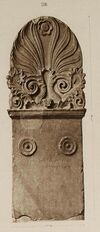
|
Funerary | 1795 | ca. 340 BC[2] | British Museum (BM 1861,0726.1 and 1937,1211.1)[3] | 53 | I 116 | 424,2 | 45 | III 40 | 10270 | |
| Antipatros son of Aphrodisias of Askalon = Shem son of Abdashtart of Askalon | 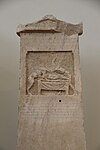
|
Funerary | 1861 | 300s BC | National Archaeological Museum, Athens (NM 1488) | 54 | I 115 | 424,1 | 46 | 32 | 8388 | |
| Benḥudeš, son of 'Abdmilqart, son of 'Abdšamaš, son of TGNṢ of Kition[4] = Noumenios of Citium |
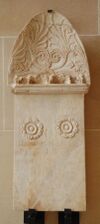
|
Funerary | 1794[5] | ca. 300 BC[4] | Louvre (AO 4834) | 55 | I 117 | 424,3 | 47 | 34 | 9034 | |
| Erene of Byzantium | 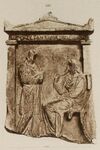
|
Funerary | 1831 | Archaeological Museum of Piraeus (3582) | 56 | I 120 | 425,1 | 48 | 8440 | |||
Piraeus inscriptions
| Dedicated to | Image | Type | Discovered | Date | Current Location | Concordance | ||||||
|---|---|---|---|---|---|---|---|---|---|---|---|---|
| KAI | CIS / RÉS | NE | KI | NSI | TSSI | IG II2 | ||||||
| Maḥdaš son of Pene-Simlat of Kition = Noumenios of Kition |
Funerary | 1884 | 200s BC | 57 | R 388 | 425,2 | 49 | |||||
| Askun-Adar | 
|
Dedication | 1871 | 100 BC | Archaeological Museum of Piraeus | 58 | I 118 | 425,5 | 50 | |||
| Asepte daughter of Sysemelos of Sidon = Asept daughter of Ešmunšillemi of Sidon |
Funerary | 1841 | 200s BC | Archaeological Museum of Piraeus | 59 | I 119 | 425,3 | 51 | 35 | 10271 | ||
| Diopeithes of Sidon = Shema'ba'al son of Magon |

|
Decree | 1887[6] | ca. 300 BC[7] | Louvre | 60 | R 1215 | 425,4 | 52 | 33 | III 41 | 2946 |
| Abdešmun son of Šallum son of Ab[...] | 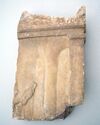
|
Funerary | 1842 | Archaeological Museum of Piraeus (3850) | I 121 | |||||||
References
- ↑ Bäbler, Balbina (3 May 2011). Fleissige Thrakerinnen und wehrhafte Skythen: Nichtgriechen im klassischen Athen und ihre archäologische Hinterlassenschaft. Walter de Gruyter. pp. 131. ISBN 978-3-11-093463-2. https://books.google.com/books?id=3p5G418I-5UC&pg=PA130. "Es gibt insgesamt achtzehn Grabstelen für Phönizier in Attika (Kat. 51-68), womit diese die zweitgrösste Gruppe nach den Thrakern mit fünfundzwanzig Monumenten bilden. Ihr auffälligstes Merkmal ist die Zweisprachigkeit: Neun Stelen tragen neben der griechischen auch eine phönizische Inschrift. Bemerkenswert ist ferner, dass vierzehn der erhaltenen Stelen für Männer errichtet wurden und diese fast alle im Namen die Angabe ihrer Herkunftsstadt tragen, nicht die nur die allgemeinere Bezeichnung ihrer Volkszugehörigkeit, wie die meisten anderen Nichtgriechen."
- ↑ Pitt 2022, p. 37.
- ↑ Marble stele of a Phoenician resident of Athens with a bilingual inscription in Greek alphabetic and Phoenician scripts, British Museum
- ↑ 4.0 4.1 Briquel-Chatonnet 2012, p. 622.
- ↑ Héron de Villefosse, Antoine (1901). "L'histoire d'une inscription (addition à une note de M. Philippe Berger)" (in fr). Comptes rendus des séances de l'Académie des Inscriptions et Belles-Lettres (PERSEE Program) 45 (1): 35. doi:10.3406/crai.1901.16700. ISSN 0065-0536. https://www.persee.fr/doc/crai_0065-0536_1901_num_45_1_16700.
- ↑ Renan, Ernest. “INSCRIPTION PHÉNICIENNE ET GRECQUE DÉCOUVERTE AU PIRÉE.” Revue Archéologique 11 (1888): 5–7. http://www.jstor.org/stable/41728884.
- ↑ Baslez & Briquel Chatonnet 1991, p. 229.
Bibliography
- Baslez, M.-Fr.; Briquel Chatonnet, Fr. (1991). "Un exemple d’intégration phénicienne au monde grec : les Sidoniens au Pirée à la fin du IVe siècle". Atti del II congresso internazionale di Studi fenici e punici, volume 1. Rome. pp. 229–240.
- Briquel-Chatonnet, Françoise (2012). "Les inscriptions phénico-grecques et le bilinguisme des Phéniciens". Comptes rendus des séances de l'Académie des Inscriptions et Belles-Lettres 156 (1): 619–638. doi:10.3406/crai.2012.93458. https://www.persee.fr/doc/crai_0065-0536_2012_num_156_1_93458.
- Hildebrandt, Frank (2006). Die attischen Namenstelen : Untersuchungen zu Stelen des 5. und 4. Jahrhunderts v. Chr.. Berlin: Frank & Timme. ISBN 978-3-86596-072-6.
- Pitt, Robert (2022). "Attic Inscriptions in UK Collections. Vol. 4.6. British Museum. Funerary Monuments". AIUK 4 (6): 37–39. https://www.atticinscriptions.com/papers/aiuk-46/. Retrieved 9 January 2023.
- Tribulato, Olga (2013). "Phoenician Lions: The Funerary Stele of the Phoenician Shem/Antipatros". Hesperia: The Journal of the American School of Classical Studies at Athens 82 (3): 459–486. doi:10.2972/hesperia.82.3.0459. ISSN 0018-098X. http://www.jstor.org/stable/10.2972/hesperia.82.3.0459. Retrieved 29 October 2020.
External links
- Artemidorus stele on Attic Inscriptions Online
- KAI 60 on the Louvre site (AO 4827)
- Noumenius stele on the Louvre site (AO 4834)
 |

